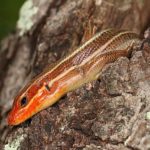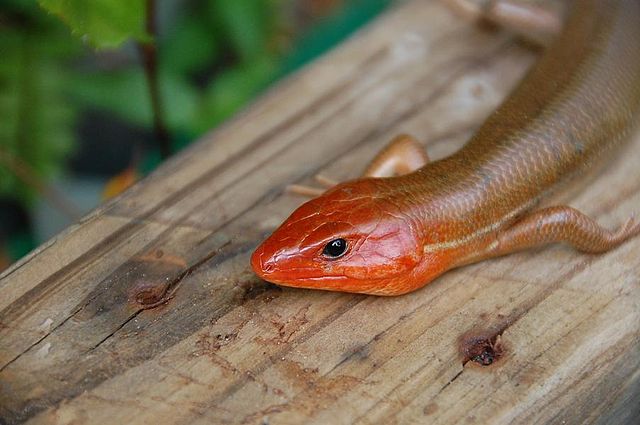Imagine my shock when I saw a fire-engine red lizard face sticking out of my rock wall in the garden. I yelled for my husband: “There’s a giant salamander out here!” Because of course I know we don’t have lizards in Delaware. Salamanders, however, are a different matter. I see them all the time in our leafy, shady back yard, especially when I turn over a rock. So I figured this was some huge, mutant salamander cruising around.
We tried in vain to catch this guy to get a better look but the little critter was super quick and easily got away. My husband even created a trap for it using a soda bottle but the thing was too savvy to step in. For weeks I told everyone we had a humongous salamander in our back yard until my husband, with help from Google, identified it as a skink.
Skinks grow to anywhere from 6 to 12 inches long. They have smooth, shiny, overlapping body scales. Their color ranges from brown to black, with white to cream stripes, and reddish orange on their heads. They can regenerate their tails!!! Males have wider heads and lose their stripes as they age. Females retain their stripes for life although they fade with age. Adult females are smaller than males. Females leave a scent trail from a gland on the tail when they are receptive.
Momma skink lays 6 to 15 eggs in June or July in a decaying log or stump in which she digs a hole for a nest and remains to guard her eggs until they hatch in September.
Skinks forage under the leaf litter and in trees for both invertebrates and vertebrates. They use chemosensory and visual cues to hunt for prey. Escape from predators is made by climbing trees, swimming, or hiding under debris.
We’ve only seen this reclusive creature a few times since and he doesn’t stick around to be observed but I hope he stays here. And I won’t even yell next time he surprises me in the yard.



TrackBack URL
https://www.karenfurst.com/blog/broad-headed-skink/trackback/